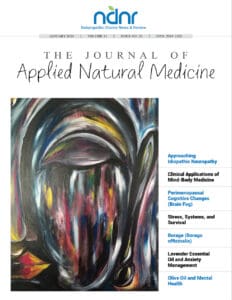Heidi Weinhold, ND
Systemic lupus erythematosus (SLE) is a chronic autoimmune disorder in which the body produces autoantibodies (antibodies that attack normal healthy tissue). These autoantibodies can attack the skin, joints, kidney, spleen, or any other organ in the body.1 The immune system in persons with SLE becomes severely dysregulated, and the body is unable to recognize what is normal healthy tissue and what is foreign. Patients with SLE produce immune antigen–antibody complexes that become difficult for the body to clear via the spleen and liver.2
The most common symptoms of lupus are extreme fatigue, headaches, fever, painful joints, swelling, pleurisy, rashes, hair loss, photosensitivity, Raynaud syndrome, and mouth or nose ulcers.1 Most of these symptoms are caused by inflammation from immune antibody-antigen complexes.
It can also result in restrictive lung disease, myocarditis, hypertension, arrhythmias, and vasculitis.3 It is an autoimmune disease that can attack any major organ system in the body. For example, SLE may attack the nervous system, resulting in severe depression, seizures, cognitive impairment, and stroke.3 Systemic lupus erythematosus may attack the kidneys, resulting in serious renal disease such as nephritis or glomerulonephritis.3 Lupus is a chronic disease with flares and remissions. It is often called the “great imitator” because it mimics the symptoms of many other rheumatologic conditions such as rheumatoid arthritis, scleroderma, vasculitis, infection, and fibromyalgia.1 Systemic lupus erythematosus can be life-threatening, and all lupus cases should be overseen by a rheumatologist. It is important to note that the following medications can induce lupus: procainamide hydrochloride, hydralazine, and isoniazid.3 Symptoms usually resolve on discontinuation of the drug.
The Lupus Foundation of America1 estimates that 1.5 million Americans are living with SLE. Approximately 85% of individuals diagnosed as having lupus are women of childbearing age.3 However, men and children can also develop lupus. Systemic lupus erythematosus is more common in persons of color, whereby 1 of 250 black women is affected compared with 1 of 1000 white women.3 A higher prevalence of vitamin D deficiency is seen among dark-skinned women, which may partially explain the increased incidence of the disease among African Americans.2 Vitamin D deficiency has been correlated to increased risk of immune dysfunction, inflammation, and autoimmunity.2 Vitamin D3 is commonly prescribed in therapeutic dosages of 3000 to 10 000 IU daily for 5 to 9 months. Notably, hydroxychloroquine sulfate, the most common medication to treat lupus, has been shown to interfere with the conversion of 25-hydroxycholecalciferol to the more active 1,25 cholecalciferol.2
When treating patients with SLE, it is important not to prescribe immune stimulant herbs such as Echinacea because the immune system is already dysregulated, and this will exacerbate it and cause the body to create more autoantibodies. Naturopathic treatment should focus on immunomodulatory therapeutics such as homeopathy, systemic enzymes, fish oil, essential fatty acids, adaptogenic herbs, and removal of food sensitivities. Anti-inflammatory herbs and systemic enzymes, along with food sensitivity elimination, can help break up the immune antigen-antibody complexes.
Constitutional homeopathic prescriptions can lead to longer periods of remission for autoimmune conditions. However, SLE is the great imitator, and the prescriber must be prepared for the occasional mercurial flare-ups and respond appropriately. This can mean choosing a homeopathic remedy that is specific to the corresponding body organ. The remedy can be repeated according to the severity and intensity of symptoms. For example, when a patient presents with lupus-induced nephritis, he or she will be under conventional medical care, but homeopathy can be prescribed every half hour up to 10 times in 1 day to help bring the inflammation down quickly. The advantage of using homeopathy is that it does not put stress on the detoxifying organs and will not interfere with the patient’s medications. The following are some clinical pearls in naturopathic recommendations for acute symptoms of SLE based on the organ system affected.
Skin and Hair
When presented with a case of cutaneous or discoid lupus, consider prescribing homeopathic Natrum muriaticum (200C).4 This remedy can be helpful in a patient having lupus with rashes, macular or papular lesions, photosensitivity, hair thinning, hair loss, scarring, or alopecia.5 However, if there is scarring of the scalp due to discoid involvement, Natrum muriaticum will not be effective.4 There are no hair roots in scar tissue, so once scarring develops, there is no chance to reverse it. Homeopathic Sepia officinalis is also a good remedy to consider for a patient who presents with the classic butterfly rash across the nose and cheeks and is especially appropriate if the patient has symptoms of menorrhagia, arthritis, or uterine prolapse.5 In addition to a constitutional remedy, the homeopathic cell salt Natrum muriaticum can be prescribed for skin involvement in 6X potency, 2 tablets BID or QID, to be taken daily for 3 months.4 In general, the homeopathic group of Natrum salts can be extremely effective in treating SLE.
Some patients with lupus have a sensitivity to wheat products. Such was the case in my experience in a 25-year-old woman diagnosed as having lupus who experienced hair thinning, vasculitis, and fatigue. She tested positive for food sensitivities to gluten. Her fatigue and vasculitis symptoms improved with the combination of homeopathic Pulsatilla nigricans (200C) and Secale cornutum (200C). Remedies were alternated weekly. She was also receiving high doses of systemic enzymes, a proprietary herbal formula containing ginger, green tea, turmeric, holy basil, hu zhang, Chinese goldenthread, barberry, oregano, Baikal skullcap, vitamin D (2000 IU), methylcobalamin oral drops, and vitamin B12 injections administered once every 2 weeks, as well as high doses of gamolenic acid, eicosapentaenoic acid, and docosahexaenoic acid. Her vasculitis symptoms resolved after a couple of weeks, and she noted increased energy. However, she continued to experience thinning hair until she noticed that there was gluten in her shampoo. When she changed to a shampoo formula without gluten, her hair grew thicker and longer much more quickly.
Kidney
It is estimated that 50% of persons living with SLE will develop clinical nephritis, hematuria, or proteinuria.2 Renal failure is a leading cause of death in patients with SLE; therefore, any symptoms of nephritis should be treated aggressively.3 Supplementing with doses of coenzyme Q10 can be renoprotective. Investigations using the herb Astragalus show that it can stimulate natural killer cell activity in patients with SLE.6 Astragalus can help reduce proteinuria that is associated with lupus nephritis.6
Natrum phosphoricum (200C) is an excellent remedy for renal insufficiency and nephritis associated with lupus. For acute recurring urinary tract infections, this remedy can be prescribed in the 200C potency hourly up to 10 doses per day for 3 to 5 days.4 Homeopathic Natrum phosphoricum (6X) cell salt is frequently prescribed for renal involvement (2 tablets BID or QID) in addition to the constitutional remedy. This low-dose Natrum phosphoricum acts like a gentle homeopathic antibiotic and helps prevent urinary tract infections.4
In the case of lupus nephritis with much fluid retention and albumin in the urine, consider prescribing homeopathic Apis mellifica (200C).4 Indications for homeopathic Apis mellifica include swelling of the joints, skin affections, and edema.5 Apis mellifica is an excellent diuretic and can help manage symptoms of lupus nephritis in addition to a patient’s conventional medical treatment. I caution that the use of Apis mellifica for longer than 3 months can put a strain on urine output.4 Usually, I have the patient take this remedy (4 pellets QID) once a week or once every other week until symptoms resolve.
Joints
Ninety percent of patients with lupus experience joint symptoms, but arthritic complaints will seldom be elucidated on radiographs.3 Patients with SLE produce immune antigen-antibody complexes that become difficult for the body to clear via the spleen, liver, and kidneys. Much of the inflammation and complaints about body aches and fatigue are owing to these circulating immune complexes. Systemic enzymes can be effective in reducing these immune complexes, decreasing inflammation and pain, and helping relieve muscle soreness. Compared with nonsteroidal anti-inflammatory drugs, systemic enzymes are much gentler on the stomach and do not carry as much risk for bleeding. Homeopathic Rhus toxicodendron and Bryonia alba can offer symptomatic relief and are frequently prescribed in low doses on an as-needed basis, with good results. Natrum sulphuricum commonly comes up in the differential for symptoms of polyarthritis, pain, and joint swelling. Homeopathic Medorrhinum is prescribed as a nosode once a month in the case of much spinal or vertebral involvement.4
Patients with lupus will experience flare-ups of their condition, which can be worsened by stress. Homeopathic Belladonna (200C) has been helpful for acute inflammatory states marked by sudden high fevers, redness of the face, and headaches.5 This remedy helps relieve inflammation and fever quickly and can be prescribed frequently until inflammation subsides. When lupus has attacked the spleen, I have found the homeopathic remedies Spongia and Ceanothus americanus to be helpful.4
Heart
The incidence of myocardial infarction is 5 times higher among persons with SLE than among the general population.3 Patients with SLE may benefit from a Mediterranean diet or a vegan diet such as the Dean Ornish program (Eat More, Weigh Less: Dr. Dean Ornish’s Life Choice Program for Losing Weight Safely While Eating Abundantly [New York, NY: HarperTorch]). It is essential to remove foods that are high in arachidonic acid and saturated fat (cow’s milk, red meat, and pork), which promote inflammatory pathways in the body. Arachidonic acid is the direct precursor to proinflammatory prostaglandins and leukotrienes. Inflammation can irritate the lining of the arteries. Systemic lupus erythematosus is characterized by inflammation in the artery lining, increased low-density lipoprotein cholesterol synthesis, hypertension, and organ damage.7 Autoimmune conditions also create free radicals, which induce the production of proinflammatory cytokines.7 Elevated levels of oxidative stress in patients with lupus may induce formation of plaques in the arteries. Research is under way to evaluate the use of antioxidants such as green tea, curcumin, resveratrol, capsaicin, and eicosapentaenoic acid for their anti-inflammatory and antioxidant activities in patients with lupus.7
For patients following a vegan diet, it is important to note that the amino acid l-canavanine, the key constituent in alfalfa, has been implicated in exacerbation of SLE symptoms. l-canavanine is found in many legumes, including soybeans, alfalfa sprouts, clover, and onions.2 Cooking destroys lupus-eliciting effects without decreasing lipid-lowering properties.2
Astragalus membranaceus is considered an adaptogenic herb and helps in immunodeficiency states. Astragalus has been shown to inhibit viral replication in heart tissue in patients diagnosed as having viral myocarditis.6 Astragalus has also been shown to relieve symptoms of angina and to improve cardiac function on electrocardiogram by 82.6%.6 Saponins found in Astragalus have been shown to decrease blood coagulation.6
Common homeopathic remedies for cardiac involvement that come up on repertory consultation include Arsenicum album (pericarditis, gaspy, and restless), Phosphorus, and Sulphur.5 Lachesis should be at the top of your list for treatment of cerebral hemorrhages and stroke. It is important to give these remedies early and frequently. The remedy can be prescribed in half-hourly doses up to 10 doses daily every day for 1 week to help get a patient through a crisis.4
Many patients with SLE are on high-dosage regimens of prescription medication such as prednisone, cyclophosphamide, hydroxychloroquine sulfate, and nonsteroidal anti-inflammatory drugs. The most effective treatment of lupus may be the integration of nutraceuticals, botanicals, homeopathy, and dietary modifications. High doses of medications may be given to patients during acute flare-ups to suppress inflammation, limiting the ND to the use of homeopathy. Once an acute flare-up is under control, the ND can discuss lowering medication levels and introduce additional naturopathic support.
 Heidi Weinhold, ND, is a naturopathic physician who is in private practice in Pittsburgh, PA. She is also the President of Appalachian Botanicals LLC and enjoys formulating unique botanical formulas. She is a graduate of Southwest College of Naturopathic Medicine and is the current Legislative Chair of the Pennsylvania Association of Naturopathic Physicians. To reach Dr Heidi, visit her Web site www.doctorheidi.net or catch her tweets at drheidiproducts.
Heidi Weinhold, ND, is a naturopathic physician who is in private practice in Pittsburgh, PA. She is also the President of Appalachian Botanicals LLC and enjoys formulating unique botanical formulas. She is a graduate of Southwest College of Naturopathic Medicine and is the current Legislative Chair of the Pennsylvania Association of Naturopathic Physicians. To reach Dr Heidi, visit her Web site www.doctorheidi.net or catch her tweets at drheidiproducts.
References
- Lupus Foundation of America. Welcome to LFA. http://www.lupus.org. Accessed January 27, 2011.
- Vasquez A. Integrative Rheumatology: Concepts, Perspectives, Algorithms, and Protocols. 2nd ed. Fort Worth, TX: Integrative and Biological Medicine Research and Consulting LLC; 2007:255-278.
- McPhee SJ, Papadakis M. 2009 Current Medical Diagnosis & Treatment. 48th ed. New York, NY: McGraw-Hill/Lange; 2009:731-734.
- Ramakrishnan AU. Advanced therapeutics on autoimmune diseases. Homeopathic seminar presented at: British Institute of Homeopathy, U.S.A Division; June 2007; Egg Harbor Township, New Jersey.
- Boericke W. Materia Medica With Repertory. 9th ed. Santa Rosa, CA: Boericke & Tafel Inc; 1997.
- Astragalus membranaceus: monograph. Altern Med Rev. 2003;8(1):72-77.
- Sukar SG, Rossi E. Oxidative stress and nutritional prevention in autoimmune rheumatic diseases. Autoimmun Rev. 2004;3(3):199-206.

